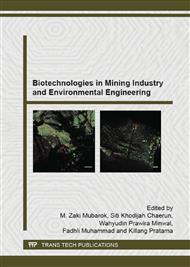p.551
p.555
p.560
p.564
p.568
p.572
p.577
p.581
p.585
Study on As Uptake and Rhizobacteria of Two as Hyperaccumulators Forward to As Phytoremediation
Abstract:
As a strategy of arsenic-containing mine tailing soil, the application of arsenic hyper-accumulator plants such as Pteris vittata shows high potential. Previous studies suggest that the arsenic uptake by P. vittata is largely determined by arsenic speciation, which is strongly influenced by microbial activities. In this study, two arsenic hyper-accumulators, P. vittata that is a subtropical plant and Pteris multifida that has been found in northeastern Japan, were selected and the their rhizobacteria were investigated. Pot experiments of P. vittata and P. multifida cultivation were performed. The concentration of total arsenic in the plant samples was monitored by inductively coupled plasma - mass spectrometry. Microbes in the rhizosphere samples were investigated by 16S rDNA library analysis and arsenic resistant bacteria isolation. The results showed that both ferns accumulated As, while P. multifida was more resistant to cold weather. Two ferns presented different rhizobacterial communities and cultivatable bacteria number, but bacteria that contain As(III) oxidase gene or As(III) oxidation activity were confirmed in both rhizosphere samples. The results of present study suggested that the cultivation of ferns changed the microbial communities in soil (rhizosphere), and microbial activity in the rhizosphere played a role in As(III) oxidation. Since ferns absorbs As(III) and As(V) in different efficiency, this study provided hints when linking microbial As transformation to As uptake by ferns which is important when designing pre-treatment procedures of phytoremediation.
Info:
Periodical:
Pages:
568-571
Citation:
Online since:
November 2015
Authors:
Price:
Сopyright:
© 2015 Trans Tech Publications Ltd. All Rights Reserved
Share:
Citation:


